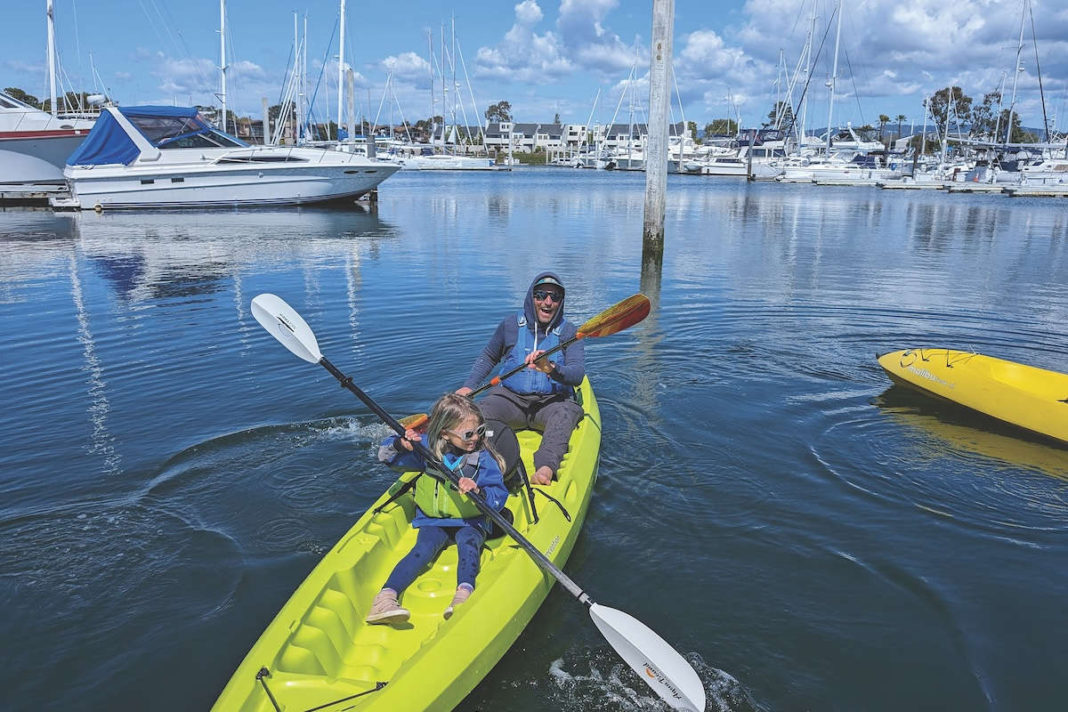There’s something in the water in Alameda, and it might be a group of 50 8th graders in kayaks: Sea Trek just opened a second location at the Ballena Isle Marina after over three decades leading kayak and stand-up paddleboard trips and rentals out of Sausalito.
Alameda, our laid-back East Bay island, used to be a mere peninsula. In 1901, a little canal was scooped out along what is now the edge of Fruitvale, to make it easier for ships to bring goods to Oakland. Now, tucked along Alameda’s unassuming shoreline are some of the calmest, least-windy waters in the bay—which make it perfect for beginner kayakers and paddle boarders.
Sea Trek’s CEO, Galen Licht, grew up on the water. The company was founded by his father back in 1982. For him, paddling has a powerful potential to build a new kind of relationship with the natural world in our backyards.
“You’re all of a sudden at an arm’s reach, immersed,” says Licht. A paddler is up close with nature, in the thick of the marine ecosystem. “It’s a very unique and different perspective.”
To show this perspective firsthand, Licht guided me around a south-facing segment of the shoreline on a mini paddling trip—and as we paddled to Old Alameda Point, it was impossible not to appreciate our waterbird’s-eye view of the bay. It was a familiar vista from a very new angle; just beyond the neon yellow noses of our kayaks, giant container ships loomed on the horizon below the San Francisco skyline, gulls snatched fish a few yards away, and rocks exposed by low tide dripped with a seaweed crust.
It’s one of Sea Trek’s core beliefs that for someone to care about an area, they need to feel connected to it. “There are many ways that people can feel connected to their home, to their space, to nature,” says Licht. “We’re trying to offer one door: have water experiences.”
The opening of the Alameda location was partly motivated by a desire to get more kids out on the water. “They get this great experience of being outside in nature, right in their backyard, outside their house,” says Licht. “The hope is that we’ll be able to provide water experiences to thousands of kids each year, because it’s so much more accessible for schools and people that live in the East Bay.”
In Alameda, they saw an opportunity to add value to the area amid an ongoing waterfront revitalization, and increase access to nature. They’ve started working with Oakland Goes Outdoors, which helps students in the Oakland Unified School District get outside—when I visited, they’d recently had groups of 50 and 80 students out on the water, broken into smaller pods of 12 explorers.
Sea Trek cares deeply about getting first-timers out on the water, and giving them that connection to the bay. “We’re a private, for-profit business, but we have a mission,” says Licht: “Provide enriching paddling experiences that foster deeper connections to nature, friends, family and self while cultivating environmental stewardship and caring for our communities in the San Francisco Bay Area and beyond.”
It’s a mouthful of a mission, but Sea Trek’s organizational attitudes bear it out—from their family-oriented vibe (many of their instructors and guides have been around for decades, and their kids are now instructors and guides) to their pricing (a membership comes with free rentals for kids under 15 in same family) to their focus on making water experiences more accessible.
“Outdoor recreation is predominantly a white space,” Licht says. “I find it important for us as a business to recognize that, and be proactive.”
In Alameda, they’re partnering with Emily Taylor, who creates outdoor adventure programs for BIPOC, LGBTQ and neurodiverse youth in the Bay Area. “Our main focus is getting BIPOC and LGBTQ underrepresented folks into the nature environment,” says Taylor. “But we also have to bridge that in a way that’s healthy for us and our bodies.”
Sometimes that means having conversations with outfitters “about what it means for us to have sovereign joy,” says Taylor. “And looking at us like adventurers and treating us like adventurers, and not like newbies.”
Taylor has been bringing groups to Sea Trek regularly, and the kids are adventure pros. “What’s beautiful is that I have six and seven year olds who all come out and know how to pull their own boats, grab their own gear, put their stuff in the slip and take off on their own,” says Taylor. “Sea Trek has actually become more of a family. They’ve become a bigger part of the bridge that we’ve been looking for.”
Sea Trek recently hosted a Summer Solstice party with music, food and discounted rentals; 20% of proceeds went to Taylor’s organization, Brown Girls Climbing, through their “Sea Trek CARES” program, which donates some of their profits to local groups that promote community involvement and collaboration for bay conservation and stewardship.
For Sea Trek, community involvement also looks like forging connections with local businesses. They surveyed paddlers at their Sausalito location and found that 60% of their customers pair their trip out on the water with a meal or coffee in the area. Licht anticipates that the same thing will play out in Alameda, as people take advantage of the growing number of restaurants, cafes and breweries next door and contribute to the ongoing revitalization of the Alameda waterfront.
Another big part of pushing accessibility is making paddling logistically easy for beginners. “We thought through all the barriers and tried to remove as many as possible,” says Licht. The price of the kayak or paddleboard rental includes all the additional gear you might need: life jacket, dry bag, pants, windbreaker. All customers need to do is bring themselves (ideally wearing some sunscreen and sunglasses—it gets bright out there).
Once one is kitted up and snug in a boat, there are a variety of options for different skill levels and interests. World War II buffs can paddle north to the USS Hornet at the former Naval Air Station; wildlife lovers can look for roosting pelicans on Breakwater Island or harbor seals lounging on a floating dock. Those looking for a leisurely outing can have a relaxed paddle around the tranquility of the marina; more ambitious seafarers can circumnavigate the entirety of the island. There’s something for any skill and ambition level.
“Some people come back soaked; some people come back totally dry,” says Licht. But everyone is usually pretty hyped about their day out on the bay. “People come back with smiles on their faces.”
The sightseeing from an Alameda kayak is charming and eclectic: sleek boats docked in the marina with intriguing names like Lil’ Bear and No Witnesses, a great blue heron flapping overhead, families scattered across Encinal Beach. Paddlers regularly see pods of dolphins skipping by, or get peeped at by round-headed seals. It’s a uniquely East Bay blend, and Licht thinks that more people should get to see it.
Says Licht, “People come on the water and are like, “Wow—this is my home.”













